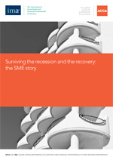To gain better understanding of how small and medium-sized businesses (SMEs) are experiencing a crucial period of change and economic recovery, ACCA and IMA commissioned a special analysis of the SME responses received through the quarterly ACCA–IMA Global Economic Conditions Surveys. This report provides a unique SME insight, shedding light on how SMEs have survived and thrived the latest period of global economic developments and drawing lessons for the future.

September 2012 marked a turning point for the global economy and ACCA–IMA’s analysis has shown that small businesses are broadly keeping up with their larger counterparts, showing optimism and confidence that economic recovery will be sustained. Mid-market companies showed the highest levels of optimism but, at the other end of the spectrum, micro businesses were least confident in both their own business prospects and the economic recovery, indicating that micro businesses may be lagging behind the general trend. Overall, the strongest upturn was seen in the US, especially among US mid-market companies.
SMEs globally continued to face a tough environment with substantial pressure on profit margins; 89% of SMEs were under pressure from domestic economic conditions, with tightening profit margins emerging as a major issue. This was especially true in emerging markets, where demand remained weak and inflation pressures intensified.
Despite these problems, small and medium-sized businesses were less likely than larger ones to have responded to economic pressures with a loss of business capacity; they had held back on staff cutbacks and capital investment. Arguably, they also had less spare capacity on which to draw upon to make such cutbacks.
Access to growth capital had improved in all major ACCA and IMA markets, but a different kind of ‘credit crunch’ was setting in: the combination of a return to growth and continued problems in accessing finance have squeezed SMEs’ cash flow. This is a common trend in periods of recovery highlighting the particular fragility of SMEs in these periods, when new orders are increasing the amount of working capital to be financed, while SMEs find it hard to finance growth, owing to a lack of liquidity. As a result, SMEs increasingly draw on each other via trade credit and late payment and the ACCA–IMA surveys confirm this, showing SMEs’ reporting of late payment concerns increasing in line with the increase in economic confidence.
An interesting trend emerged, with business size influencing the type of economic recovery measures businesses took. With profit margins under pressure, micro and small businesses were more likely to seek shelter from competition in niche markets or segments and mid-market firms were more likely to enter new markets, while large corporates were more likely to pursue innovation. Encouragingly, however, businesses of all sizes demonstrated a similar commitment to quality.
This report provides evidence of recovery among the ‘mid-market’ firms: defined here as businesses above the usual SME size threshold (249 employees) whose finance staff nevertheless still considered the business to be an SME. While this group was originally introduced to the study in order to reconcile varying SME definitions across markets, the findings confirm that this is a distinct group of tremendous importance to the global economy, representing varied national SMEs. Analysis for this report shows mid-market companies to be more extroverted and dynamic and thereby better placed to take advantage of any economic opportunities, addressing some issues like small businesses and others like large corporates. They are also exposed to threats, such as FX risk, to which smaller businesses are rarely exposed. Mid-market companies were more likely than other SMEs to see opportunities arising for their business in the recovery and to respond to these by adding capacity. Along with large corporates, however, they were also more likely to respond to economic pressures with cost cutting and loss of capacity. Mid-market companies were the only business size segment to report a significant improvement in profitable investment opportunities in 2013.
Singapore, the UAE and Canada emerged as the markets with the most SME-friendly policies over this period, in the sense that finance professionals in SMEs gave government policies more positive ratings than did their colleagues working for large corporates. Government came in for relatively harsher criticism by SMEs in markets such as Pakistan and the US.
In most developed countries, SMEs appear to have adjusted their expectations of government spending since growth started to return in late 2012 and calls for more spending have generally decreased. Finance professionals in US SMEs have been particularly persistent in their opposition to the government’s fiscal policy. On the other hand, emerging economies, especially in the Asia Pacific region, have seen the opposite trend – as growth slowed, calls for more spending naturally increased. SMEs in austerity-hit countries demonstrated growing ‘austerity fatigue’, increasingly expecting governments to ease the rate of spending cuts as fiscal adjustment progressed.
Finally, the study reveals how political instability emerged as a substantial issue for SMEs in key regions. Elections and, perhaps more importantly, polarised politics from the US to south Asia strongly affected business sentiment and investment in late 2012 by creating mistrust and uncertainty.


